That being said, I would encourage leaders to look at what systems had deficiencies while transitioning to remote learning and work. Think about what actions should take place to minimize that risk to learning. Also, while leadership, commitment and training are important, you don’t need to “boil the ocean.” Instead, build short, medium-term strategies and let smaller migrations inform your long-term planning. It’s important to remember that the cloud is a transformational opportunity with a well-worn path. In fact, AWS has been building and managing infrastructure in the cloud since 2006.
Watch Chad Stevens, leader for K–12 education at Amazon Web Services, explain schools can build a cloud-first strategy.
EDTECH: Can you share some examples of how school districts have used cloud solutions for remote learning?
STEVENS: The cloud helps schools minimize risks to learning and teaching continuity. For example, cloud-based software such as Amazon Web Service’s AppStream 2.0 for Education is a cost-effective way to give students virtual access to necessary educational applications, no matter where they are. With this fully managed application streaming service, students can also access those apps on almost any device. Council Bluffs Community School District in Iowa is a good example of a school that deployed AppStream 2.0 prior to moving to remote learning. Having this in place allowed them to scale, while providing cost savings to the district. As we move into the school year, maintaining space is going to be important for students. This allows school leaders to recapture that lab space.
Another example was Los Angeles Unified School District in California, the second-largest school district in the country. LAUSD serves almost 700,000 students, and they needed to think big and move fast. They found that their community was in need of support in this time of unprecedented school closings. With AWS, they were able to set up five call centers using Amazon Connect within a matter of days. These call centers are used by the school district to field IT questions, provide remote support and enable staff to answer calls. They also opened an additional mental health hotline that can be reached by those in need of help to manage fear, anxiety and other challenges.
EDTECH: And do you have any advice for schools looking to start their cloud migration journey for next school year?
STEVENS: I outlined four key practices in my session at CoSN2020. The first is to leverage the experience of others. There have been thousands of customers who have gone before you in using the cloud — whether they’re in K–12 education, in higher education, in the government, in the private sector — so you should leverage that experience.
Next, find the right strategy for your current environment. We have the tools to help you decide what the right strategy for your environment is because every IoT device environment is a little different.
It’s also super important to build cloud skills and capabilities. Training is really key. I would encourage leaders to keep in mind that migrating to the cloud is more about people and culture rather than technology.
And finally, build a foundation for success. It’s super important to have superintendent, school board or cabinet-level buy-in for what that foundation is going to be and how you will go about the migration.









